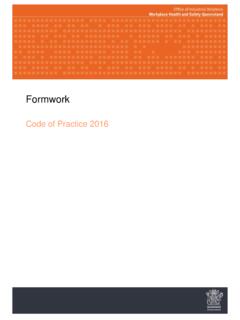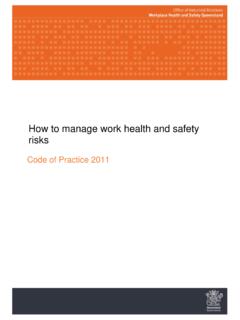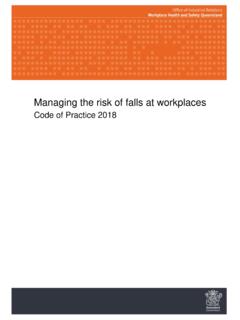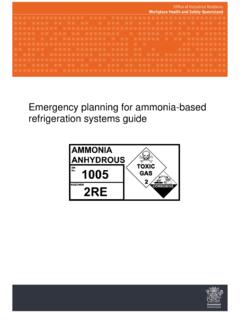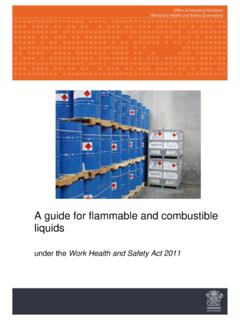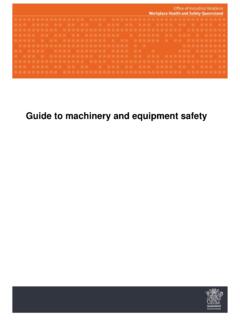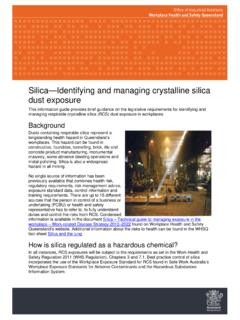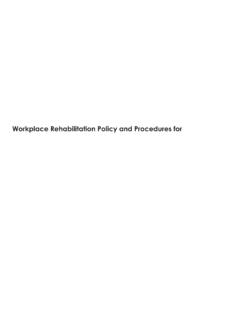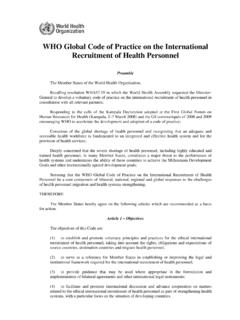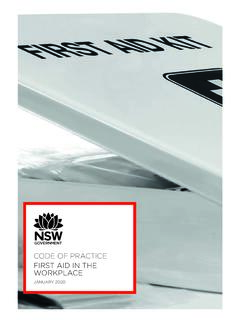Transcription of Tower Crane Code of Practice 2017 - WorkSafe.qld.gov.au
1 Tower Crane code of Practice 2017 Tower Crane code of Practice 2017 (PN12040) Page 2 of 65 This Queensland code of Practice has been approved by the Minister for Employment and Industrial Relations, Minister for Racing and Minister for Multicultural Affairs under section 274 of the Work Health and Safety Act 2011. This code commenced on 1 July 2017, with the exception of the criteria for Crane -lifted first aid boxes under Section which commenced on 1 January 2018. This code was varied by the Minister for Education and Industrial Relations on 1 July 2018. Workplace Health and Safety Queensland 1300 362 128 The material presented in this publication is distributed by the Queensland Government for information only and is subject to change without notice. The Queensland Government disclaims all responsibility and liability (including liability in negligence) for all expenses, losses, damages and costs incurred as a result of the information being inaccurate or incomplete in any way and for any reason.
2 State of Queensland 2018 PN12040 Tower Crane code of Practice 2017 (PN12040) Page 3 of 65 Contents Scope and 1. Introduction .. 6 What is a Tower Crane ? .. 6 Who has health and safety duties in relation to Tower cranes? .. 7 What is involved in managing risks associated with Tower cranes? .. 8 Safe work method statements .. 9 Information, training, instruction and supervision ..10 2. Safe design of Tower cranes ..11 Design registration of Tower cranes ..12 Design registration of Tower Crane base ..12 Crane stability ..13 Stabilising and overturning moments ..13 Footings and foundations ..13 Crane ties ..14 Wind conditions ..14 Limiting and indicating devices ..15 Reliability of devices ..15 Rated capacity limiters ..15 Motion limiting devices ..16 Working radius indicator ..16 Dual braking systems ..16 Signs on Tower cranes ..16 3. Planning and coordinating Tower Crane operations ..17 Selecting the Crane .
3 18 Crane crew ..18 Crane siting ..19 Crane Collision between the Crane with other plant or structures ..19 Location of access areas ..20 Communication ..20 Emergency plan ..20 Lighting ..21 4. Minimising risk of injury from collision ..21 Working near overhead electric lines (powerlines) ..21 Electrical safety laws ..21 Planning for work near overhead powerlines ..22 Exclusion zones for operating a Tower Crane near overhead powerlines ..22 Working near other plant (including other cranes and concrete placement booms) ..25 Ways to minimise risk of injury from a collision with other plant ..25 5. Erecting and dismantling Tower cranes ..26 Responsibilities for persons erecting or dismantling Tower cranes ..26 Minimising risk of injury from Crane collapse ..26 Erecting and dismantling ways to minimise risk of injury from Crane collapse ..26 Climbing Tower cranes - ways to minimise risk of injury from Crane collapse.
4 27 Minimising risk of injury from falling from a height ..27 Edge protection systems ..28 Tower Crane code of Practice 2017 (PN12040) Page 4 of 65 Travel restraint systems ..28 Fall-arrest harness systems ..29 Minimising risk of injury from falling objects ..29 Exclusion zones persons are prohibited from entering ..30 Tool lanyards ..30 Scheduling of work ..31 Restraining systems for Crane components ..31 6. Commissioning Tower cranes ..31 Responsibilities of persons who commission Tower cranes ..31 7. Operational issues ..32 Roles and responsibilities associated with Tower Crane operations ..32 Person conducting a business or undertaking ..32 The Crane owner ..32 The Crane operator ..33 Dogger ..34 Minimising risk of injury from lifting loads ..34 Control measures to maintain the integrity of lifting gear ..35 Control measures to minimise risk of injury from Crane overload ..37 Control measures to minimise risk of injury from unsecured and dropped loads.
5 38 Safe access on Tower cranes ..39 Tower ladders ..39 Internal guardrail on Tower landings ..39 Guardrails on machine deck and A-frame platform ..40 A-frame ladder cage ..40 Cantilevered and hanging platforms ..40 Crane jib access non-self-erecting types ..40 Leaving the Crane unattended ..40 Work boxes and first aid boxes ..41 Features and use of work boxes ..41 Features and use of first aid boxes ..42 Features of a Crane when using work boxes and first aid boxes ..43 8. Additional requirements for self-erecting Tower cranes ..43 Operation of self-erecting Tower cranes ..44 Remote operation ..44 Erection of barricade around self-erecting Tower cranes ..44 9. Training and supervision ..45 Responsibilities for training and supervision ..45 Familiarisation training ..45 Refresher training ..46 Frequency of refresher training ..46 Record of refresher 10. Inspecting, testing, maintaining and repairing Tower cranes.
6 46 Competent person for inspecting Tower cranes ..47 Inspecting specific parts of a Crane ..47 Inspecting a complete Crane ..47 Altering a Crane ..48 Requirements for non-destructive testing ..48 Crack testing of slew ring bolts ..49 Crack testing of Tower bolts ..49 Chord thickness testing ..49 Tower Crane code of Practice 2017 (PN12040) Page 5 of 65 Independent third party inspections of Tower cranes at commissioning ..50 Definition of independent third party ..50 Pre-erection inspections and tests ..50 Commissioning inspections and tests ..51 Pre-operational inspection ..51 Routine inspection and maintenance ..52 Annual inspections (when Tower cranes in place for 12 months or longer) ..52 Major inspection of Tower Crane ..53 Key inspection items for a major inspection ..53 Action following a major inspection ..56 Records of inspections and maintenance ..57 Tower Crane maintenance ..57 Tower Crane Second-hand imported Tower cranes.
7 58 Appendix 1: Dictionary ..59 Appendix 2: Relevant technical standards ..61 Appendix 3: Familiarisation training checklists ..62 Appendix 4: Example - Annual Crane safety certificate ..64 Appendix 5: Example - Crane safety certificate major inspection ..65 Tower Crane code of Practice 2017 (PN12040) Page 6 of 65 Foreword This Tower Crane code of Practice 2017 is an approved code of Practice under section 274 of the Work Health and Safety Act 2011 (the WHS Act). An approved code of Practice is a practical guide to achieving the standards of health, safety and welfare required under the WHS Act and the Work Health and Safety Regulation 2011 (the WHS Regulation). From 1 July 2018 duty holders are required to comply with an approved code of Practice under the Act. Duty holders may, for the subject matter in the code , follow another method, such as a technical or an industry standard, if it provides an equivalent or higher standard of work health and safety to the standard required in the code .
8 A code of Practice applies to anyone who has a duty of care in the circumstances described in the code . In most cases, following an approved code of Practice would achieve compliance with the health and safety duties in the WHS Act, in relation to the subject matter of the code . Like regulations, codes of Practice deal with particular issues and do not cover all hazards or risks which may arise. The health and safety duties require duty holders to consider all risks associated with work, not only those for which regulations and codes of Practice exist. Codes of Practice are admissible in court proceedings under the WHS Act and the WHS Regulation. Courts may regard a code of Practice as evidence of what is known about a hazard, risk or control and may rely on the code in determining what is reasonably practicable in the circumstances to which the code relates. An inspector may refer to an approved code of Practice when issuing an improvement notice.
9 This may include issuing an improvement notice for failure to comply with a code of Practice where equivalent or higher standards of work health and safety have not been demonstrated. Scope and application This code provides practical guidance to persons conducting a business or undertaking on how to comply with their health and safety duties when carrying out work with Tower cranes. How to use this code of Practice In providing guidance, the word should is used in this code to indicate a recommended course of action, while may is used to indicate an optional course of action. This code also includes various references to provisions of the WHS Act and the WHS Regulation which set out the legal requirements. These references are not exhaustive. The words must , requires or mandatory indicate that a legal requirement exists and must be complied with. 1. Introduction What is a Tower Crane ? A Crane is an item of plant intended for raising or lowering a load and moving it horizontally including the supporting structure of the Crane and its foundations.
10 The three general types of Crane typically referred to as Tower cranes used in Australia are: luffing hammerhead (including topless) Tower Crane code of Practice 2017 (PN12040) Page 7 of 65 self-erecting. Under the WHS Regulation: Tower Crane means a Crane that has a boom or jib mounted on a Tower structure. - For high risk work licensing purposes, a Tower Crane , if a jib Crane , may be a horizontal or luffing jib type and the Tower structure may be demountable or permanent, but Tower Crane does not include a self-erecting Tower Crane . self-erecting Tower Crane means a Crane that is not disassembled into a Tower element and a boom or jib element in the normal course of use, and where erecting and dismantling processes are an inherent part of the Crane s function. Who has health and safety duties in relation to Tower cranes? A person conducting a business or undertaking (PCBU) has the primary duty to ensure, so far as is reasonably practicable, that workers and other persons are not exposed to health and safety risks arising from the business or undertaking.
